
When most coaches hear 1-3-1 defense, they most likely think of a long and athletic team playing around in the half court forcing lob passes and trapping in the corners.
However, the 1-3-1 can also be used in a full-court setting as a press.
While the positions and rotations are somewhat different than a 1-3-1 half-court zone, it’s a fairly easy press to implement to create difficulties for the offense.
In addition, there are numerous different ways you can run it.
Meaning that all teams can find a version of the 1-3-1 full-court press that fits your personnel or have multiple ways to run it depending on your situation.
Goal of the 1-3-1 Full Court Press
At the most basic level, the goal of the full-court 1-3-1 press is to get the offense to a side and trap the ball along the sideline near half court.
Even if the press does not cause a turnover, it should result in the offense being forced to slow down to get the ball past half court, affecting their rhythm and effectiveness.
Strengths
1. Allows you to disrupt tempo
The 1-3-1 forces teams to work to get the ball past half court. Instead of being able to quickly advance the ball with the dribble or sideline pass, they will be forced to reverse the ball and take their time to get it across mid-court safely. This will waste part of their shot clock and also take them out of their offensive rhythm.
2. Allows you to pressure the ball
Since the press has three defenders across the middle and a team player protecting the basket, it allows the top defender to really attempt to pressure the basketball without the fear of getting burned. This pressure can fatigue the opponent and lead to some live-ball turnovers over the course of the game.
3. Not an overly risky press
With a constant basket defender, the 1-3-1 full court press should be able to limit easy looks by the offense. Even if they are able to break the pressure effectively, there will still be a goaltender in the lane ready to contest any potential shot.
Weaknesses
1. Larger teams can throw over the top to break the press
With the setup of a full court 1-3-1 press, there is ample space in the front court for the offense to space out to. Therefore if they have taller and stronger players, it is possible for them to throw over the top of the 2nd line into their offensive half, avoiding the traps and setting up a fast break for themselves.
2. Fatigue for the top defender
The top player in the 1-3-1 press needs to be very active and potentially guard from sideline to sideline. If the offense chooses to continually throw the ball back and forth as they break the press, it’s possible this defender becomes very worn out in the process. This can be especially damaging if this is also one of your top offensive players as well.
3. Only 1 player back to cover the basket
While the goaltender spot is most likely going to be your tallest player capable of alternating shots, that is still just one defender. No matter how good of a shot blocker this player may be, if the offense is able to get multiple players moving toward the basket after breaking pressure, they will have the advantage.
Initial Setup and Responsibilities
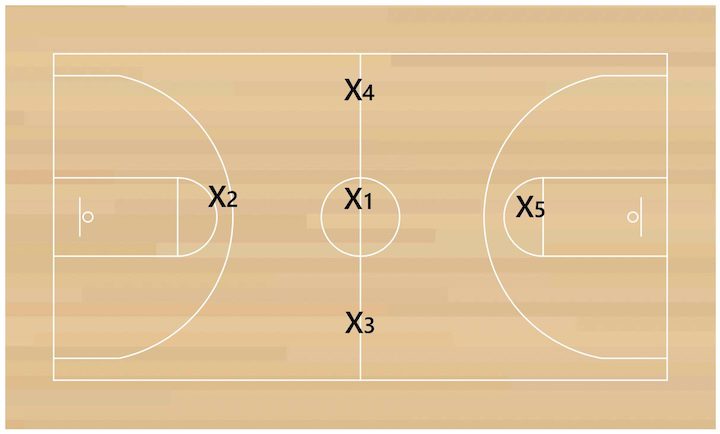
Here is a brief look at how the 1-3-1 full-court press is set up and also the order in which you should begin assigning players positions.
Top Defender
This is the most important position on the press, so it needs to be the first spot that you assign.
This defender must be athletic and able to cover lots of ground from side to side. Additionally, if they are taller and longer, that is even better since it will prevent the offense from seeing reversal passes easily and force them to throw high, slow lob passes.
This player should start somewhere around the top of the 3-point line in the backcourt if not a little inside it, depending on where the offensive players start.
Their isn’t so much to deny the inbounds pass as it is to pressure the ball once it is passed in.
Once the ball has been thrown in to a side, this top defender’s job is to keep it on that side of the floor. He does this by opening up completely to the offensive player’s side. This positioning helps to push this player to dribble up the sideline and prevents an easy reversal pass.
As the offense gets near half court, it is the top defender’s job to help the wings trap the ball handler near the half court line.
Middle Defender
Depending on how you run your 1-3-1 press, this might be the 2nd most important defender.
This player must also be very athletic and able to cover a lot of ground. Their length is not as important, but their quickness must be excellent. An added bonus is they are good at anticipating where the offense’s next pass will go so they can attempt to get some interceptions.
This player will begin somewhere around the center circle, but could scoot up as needed to match up with an offensive player.
The first responsibility of the middle defender is to keep the ball from going to the middle of the floor. Offenses will always look to get the middle to the middle to avoid traps and break down the pressure, so keeping the ball away from this area is essential for the 1-3-1 full court press to be effective.
As the ball nears the trapping area, the middle defender rotates toward the ball-side sideline to take away any passes up the floor. If they are late and the pass gets completed, they can stop the ball and get a 2nd trap set with the ball-side wing.
Back Defender
While most coaches will just automatically stick their post player here, that doesn’t necessarily need to be the case.
This player should be your best defender at the rim, not just your tallest. It is also a spot you can put a less mobile player since they don’t have to do a lot of moving from side to side and instead just stay in the paint to protect the basket.
The less mobile this player is, the closer they must stay near the basket. Either way, this player should never go past the top of the key in the front court.
Their goal is very simple: protect the basket and prevent easy baskets.
This player should never leave the lane area to try for a steal or anything unless they are ABSOLUTELY SURE they will be able to make the play. Being wrong and not making the play will likely result in a layup for the offense.
Wing Defenders
Ideal wings in the 1-3-1 press are long players who make it difficult for the offense to throw penetrating passes up the sideline because of their length.
They're also good at setting traps near the half court line without fouling. They should be fairly athletic and able to cover a decent amount of ground.
The wings should begin even with the middle defender, somewhere around the half court line. They should be wide enough so that they can cut off the sideline without getting burned.
The main responsibly of the wing defenders is to get traps set near the half court line. It could be either in the front court or the back court depending on where the ball gets stopped.
Additionally, these players must NOT give up the sideline in the back court. If the top defender is working on keeping the ball to a side, that means these wings must prevent the ball from being dribbled up the sideline without a trap getting set.
Lastly, the wings must protect the middle of the floor when they are on the weak side. As the middle player goes out to take away the sideline pass, the weak side wing must replace them to keep the ball from getting to the middle.
How to Run the 1-3-1 Full Court Press
Inbounding
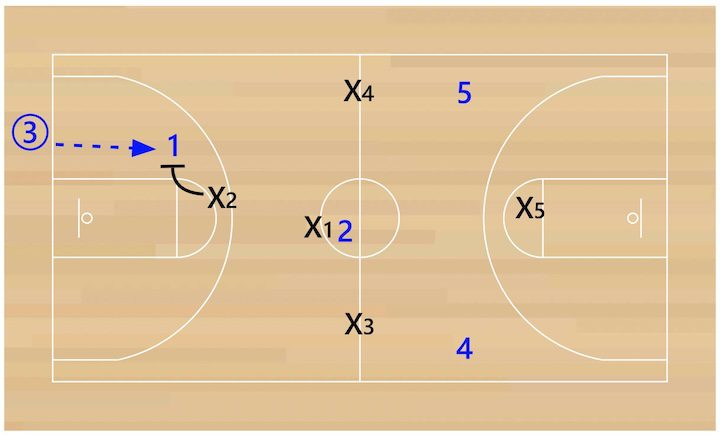
On the pass to 1, X2 immediately gets inside the ball and positions his shoulders parallel with the sideline to influence the ball handler to stay on that side of the floor.
X1 works to get in front of 2 to keep the ball from the middle of the floor.
X3, X4, and X5 all stay in their spots, ready to rotate as the ball gets advanced up the floor.
Advancing
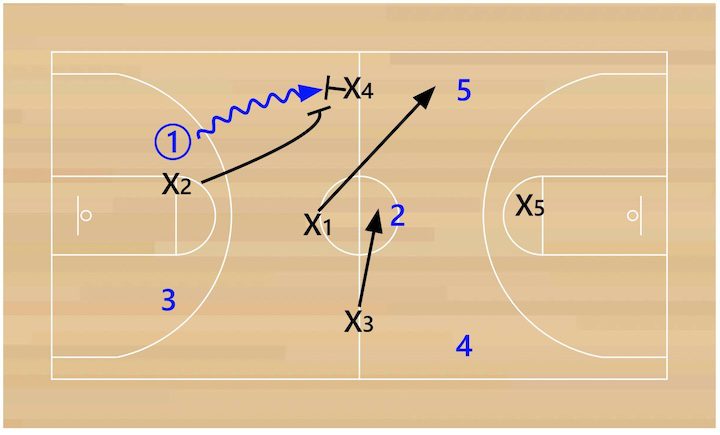
As 1 begins dribbling the ball up the floor, X2 continues to stay right on his inside shoulder and steer him toward the trap with X4. X4 can retreat a couple steps to act like there won’t be a trap before attacking the ball and getting it stopped. X4 must not give up the sideline.
As X4 steps up for the trap, X1 leaves the middle to take away the sideline pass to 5. This is a far rotation, so they need to anticipate it well to get there fast. Their aiming point should be for the hip of 5 so if they arrive late they can get behind him and stop the ball.
X3 rotates to the middle as X1 leaves it. He should already be cheating that way since the ball is on the opposite side of the floor, making it a shorter rotation for him.
X5 remains in the paint prepared for the worst-case scenario of the offense breaking the press easily and attacking the basket.
Back Court Trap
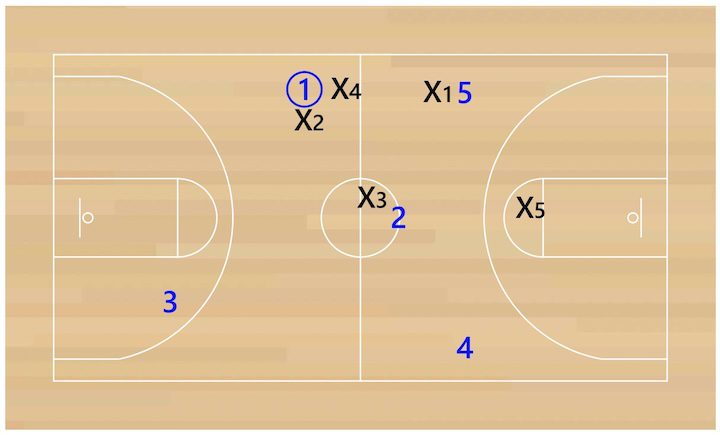
On the trap by X2 and X4 near the half-court line, the remaining players should work to deny any further penetrating passes.
X1 should deny the pass up the sideline to 5. Again, this is a far slide for him to make, so at the very least they need to be able to reach out their top hand and knock the ball out of bounds.
X3 should do everything he can to keep the ball out of the middle of the floor. He has to be aware of where the offensive players are located to take away the most dangerous player in the middle of the floor. His rule should be to start at the top of the key and work his way up, staying with the deepest player.
X5 should again remain inside the 3-point line. If there is a deep player near the lane, he can step near him. However, if there is decent ball pressure, that pass shouldn’t be a slow, lobbed pass, so he doesn’t need to all-out deny it.
On this first trap, the only pass that the offense should see available is a reversal pass in the back court.
Reversal
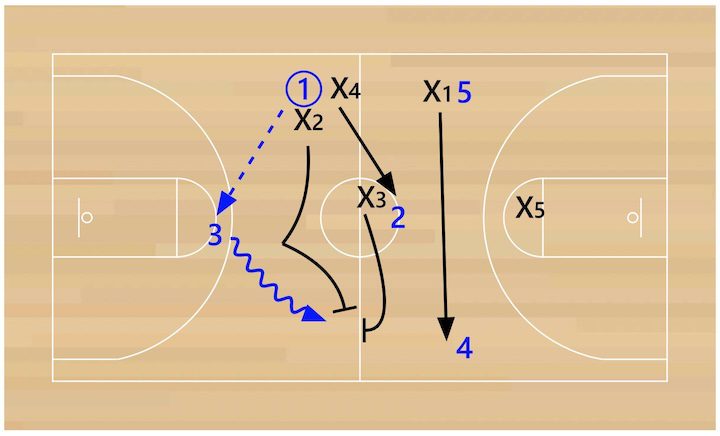
If the trap in the back court is any good, then the reversal pass have to go backwards to 3. This is important because it will give the defenders more time to complete their next rotations.
X2 does not want to immediately turn and chase the pass. Instead, he should run to where the dribbler is going to go, again trying to stay on the inside and keep the ball on a side of the floor.
The other 3 defenders rotating need to attempt to move as 1, as their rotations will leave players open briefly until they get where they are going.
X3 sprints toward the sideline to get it cut off and get a trap set. On this reversal, there’s a good chance he will need to attempt to get the trap set just past the half court line in the front court because of how far he has to rotate across the court.
X1 must sprint all the way across the floor to get to the other sideline and deny 4. And X4 must leave the first trap and rotate to the middle to take away the pass to 2.
Because of the distance many of these rotations are, there is a good chance the offense may be able to complete a pass up the sideline to the front court.
But that doesn’t the press is over. It just means the defense needs to get a trap set in the front court.
Front Court Trap
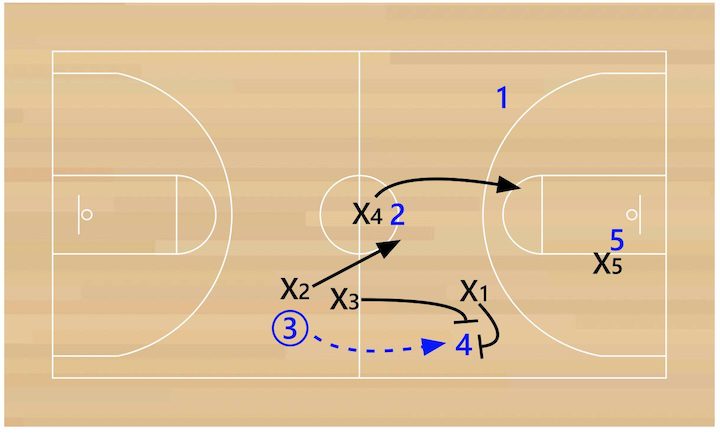
If the pass is completed up the sideline, it is X1’s job to immediately get in front of it, get the ball stopped, and cut off the sideline.
Then X3 must turn and sprint as soon as he sees the ball go past his head to chase it down and complete the trap. The quicker X3 can change direction and get there, the better the trap will be.
X5 looks around and takes away any potential pass toward the basket. If there is no one in that area, he remains there waiting for a late cutter or drive.
X2 and X4 are responsible for taking away any reversal passes. X2 takes the higher one and X4 rotates down to take away anything lower.They must keep in mind there is no need to deny anything into the back court since that will be a turnover anyway.
Aggressive Press Variation
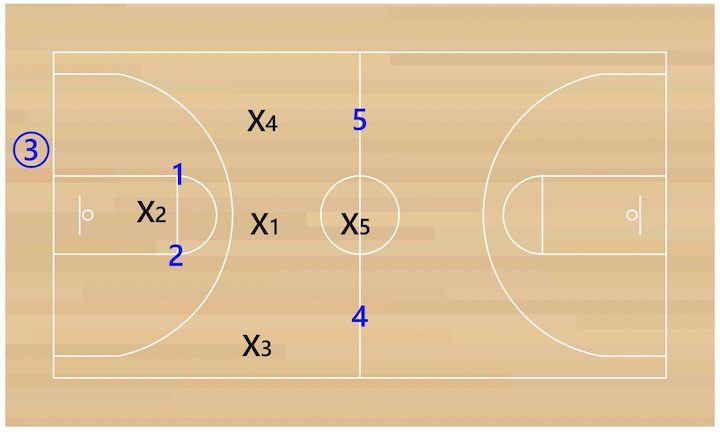
If you’re looking to add some more pressure and get your opponent to pick up their pace and play faster than they want to, this more aggressive 1-3-1 full court press can do the job.
The initial setup of the press is the same as the original version except everyone is 10 - 15 feet closer to the basketball at the start.
The top player’s role is pretty much the same, except he really attempts to push the offense to catch the ball near the corner on the inbounds pass.
On the inbounds pass to 1, X2 and X4 immediately rush in to trap the basketball. Their job is to provide maximum ball pressure without fouling. They are not looking to get a steal from this spot, but just make 1 uncomfortable.
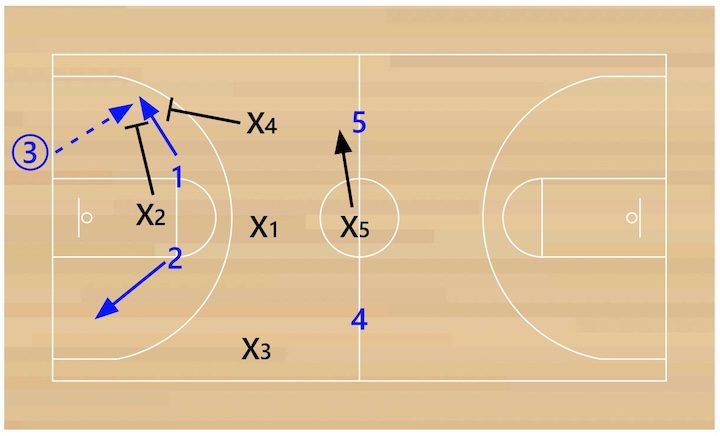
The 5’s job is MUCH different in this version of the 1-3-1 full court press. He rotates over to take away any sideline pass up the floor.
Since most teams will attempt to quickly reverse the ball to the inbounder stepping in, X3 sprints in to deny that pass. X1 then becomes a safety in the middle of the floor.
X1’s responsibilities are to take away any flash to the middle of the floor, whether that comes from in front of or behind him.
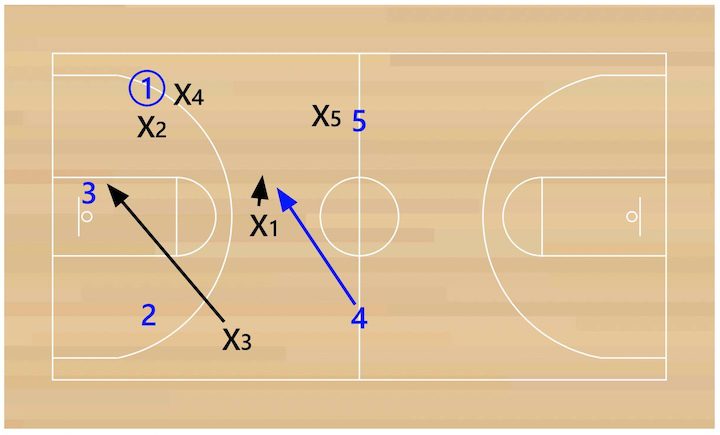
If the offense is able to reverse the basketball to the inbounder, then the defense has 2 options for how to keep the pressure on.
Either X2 bumps X3 off and becomes the top of the press again. Or X2 can instead sprint to the opposite side of the floor and leave X3 on the ball on the top of the press.
X5 would then rotate to the middle of the court and the press would be back to normal and ready to trap again once the ball gets passed out of the middle.
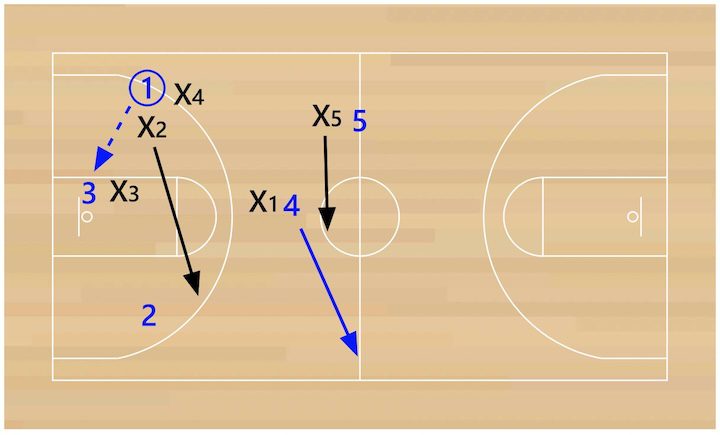
This is a very high risk, high reward type of press that can yield a lot of turnovers in a hurry.
But since it is also very risky, it’s important your players know that if the offense completes a penetrating pass to the middle, they have to sprint back and set up their half court defense.
Conclusion
The 1-3-1 full court press can be a very effective press that can effectively take an offense out of its rhythm without allowing many easy baskets in the process.
But you can also cause a lot of live-ball turnovers with it, especially if you have a lot of long, athletic defenders who can pressure the basketball and anticipate passes.
If pressing your opponent with a less-risky approach is something that interests you, consider implementing the 1-3-1 full court press before your next game.
